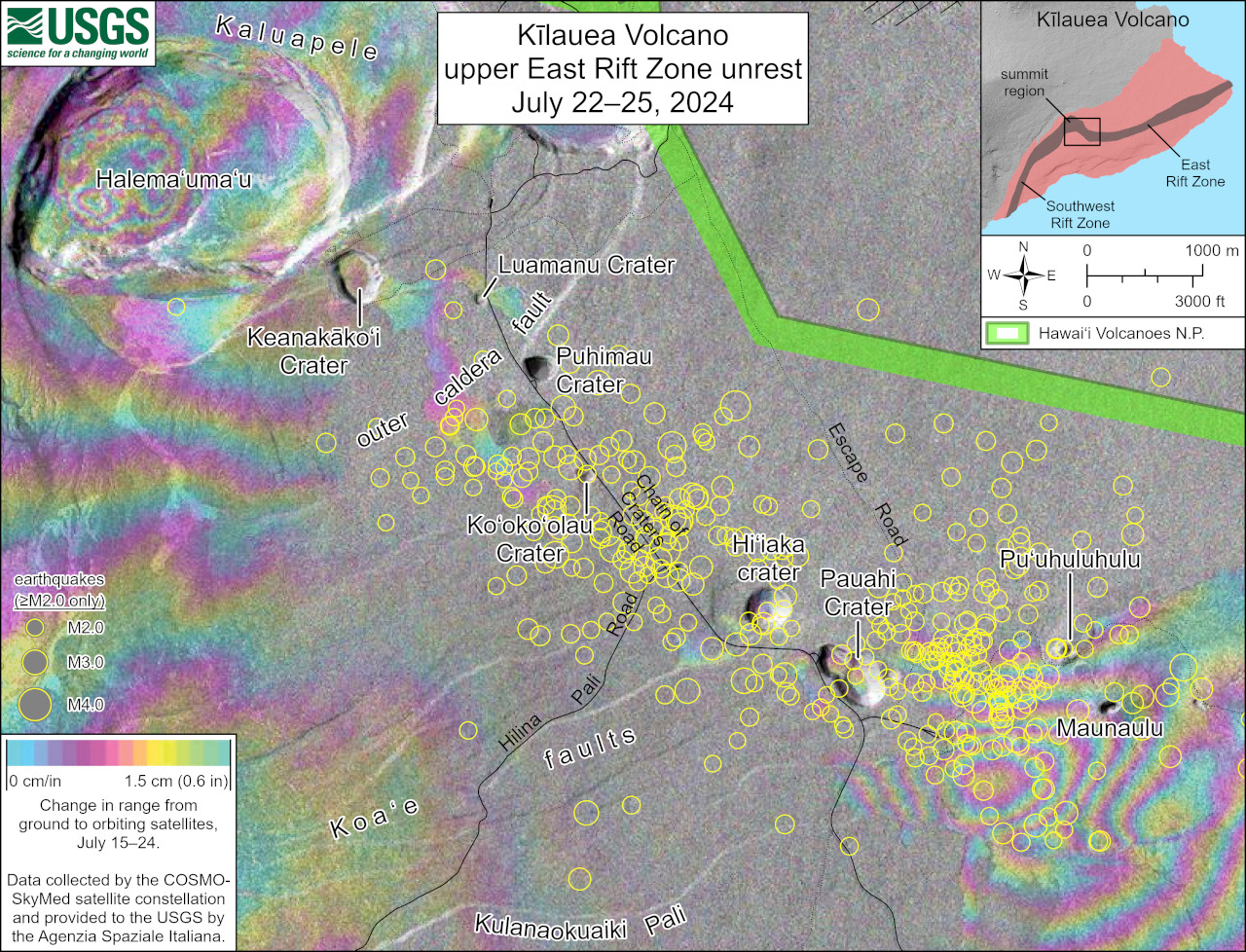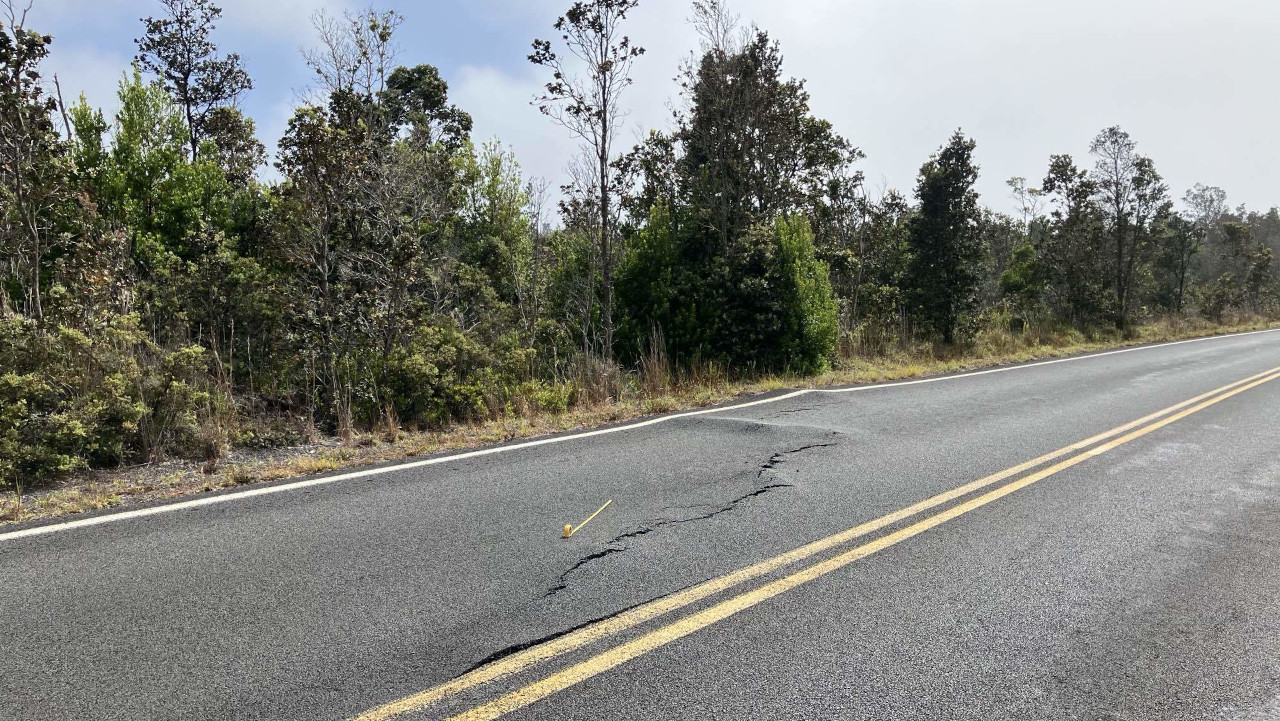(BIVN) – Kīlauea volcano is not erupting, and the unrest on the upper East Rift Zone (UERZ) appears to have ended for now.
“The fourth pulse of increased seismicity was over by midday yesterday, and overall seismicity rapidly decreased afterwards and has now returned to ordinary levels,” the USGS Hawaiian Volcano Observatory wrote on Friday morning.
The UERZ magma intrusion and unrest resulted in more than 1,500 detected earthquakes, including 30 earthquakes magnitude-3 or greater.
The USGS Volcano Alert Level remains at ADVISORY. “Additional seismic pulses or swarms may occur with little or no warning and result in either intrusion of magma or eruption of lava,” scientists wrote.
When checking for damage related to the UERZ intrusion, scientists report finding many new small cracks in Chain of Craters Road.
As of Friday morning, Chain of Craters Road in Hawaiʻi Volcanoes National Park remained closed from the Devastation intersection to the coast. Kulanaokuaiki Campground was also closed, and Escape Road (trail) and Crater Rim Trail were closed south of Nāhuku.

USGS: “This reference map depicts recent unrest along Kīlauea’s upper East Rift Zone. Earthquakes that occurred between July 22–25, 2024, are shown as yellow circles. Recent ground deformation in this region, over the timeframe of July 15-24, 2024, is shown as colored fringes; data were recorded by the Italian Space Agency’s (ASI) Cosmo-SkyMED satellite. More fringes indicate more deformation, and each color cycle represents 1.5 cm (0.6 in) of ground motion. The bullseye feature southeast of Pauahi Crater on the upper East Rift Zone indicates inflation over this time period due to magma accumulation underground.”
From the USGS HVO update on Friday morning:
Summit and Upper East Rift Zone Observations: Over the past 24 hours, there were approximately 18 earthquakes detected beneath Kīlauea’s summit, and approximately 300 earthquakes detected beneath the upper East Rift Zone (UERZ), mostly at depths of 0–4 km (0.0–2.5 mi) below the ground surface. Most of these earthquakes are associated with the fourth pulse of intense seismic activity that occurred yesterday morning, related to the UERZ intrusion which started on July 22; only approximately 60 earthquakes occurred within the last 8 hours. The fourth pulse ended by midday yesterday. Most events were smaller than magnitude-2, but there were 4 earthquakes magnitude-3 or higher in the UERZ. Tiltmeters in Kīlauea summit region (instruments SDH, southwest of the summit, and UWE, northwest of the summit) started recording inflating this morning around 3 a.m. H.S.T, suggesting magma is no longer moving into the UERZ. Field crews returned to Chain of Crater Road yesterday afternoon observed new cracks near the intrusion, and more deformation of cracks first observed on July 23. The most recent measurement of the summit’s SO2 emission rate was approximately 65 tonnes per day on July 23, 2024.
Middle and Lower Rift Zone Observations: Rates of seismicity and ground deformation beneath the middle and lower East Rift Zone and lower Southwest Rift Zone remain low. Recent eruptive activity and ongoing unrest have been restricted to the summit and upper rift zone regions. Measurements from continuous gas monitoring stations downwind of Puʻuʻōʻō in the middle East Rift Zone—the site of 1983–2018 eruptive activity—remain below detection limits for SO2, indicating that SO2 emissions from Puʻuʻōʻō are negligible.
Analysis: Recent four strong pulses of earthquake activity from July 22-25, clustered between Pauahi Crater and Maunaulu, represented stages in emplacement of an intrusive dike beneath this area. The intrusion and unrest are now over. The earthquakes and associated local deformation associated with the first three pulses were consistent with satellite data showing formation of a shallow (1-3 km, .5-2 mi) dike in this region. Deformation data was consistent with magma slowly moving out of the storage regions of the summit into the dike; deformation data now indicate this magma movement has ended. The strong pulse of earthquakes yesterday morning was clustered near the intersection of the Chain of Craters and Hilina Pali roads and was not clearly associated with dike formation. Seismic activity greatly decreased after the end of the fourth pulse, and is now back to pre-intrusion levels.


by Big Island Video News12:10 pm
on at
STORY SUMMARY
HAWAIʻI VOLCANOES NATIONAL PARK - More than 1,500 earthquakes, including 30 earthquakes of magnitude-3 or greater, were detected during the upper East Rift Zone magma intrusion and unrest.